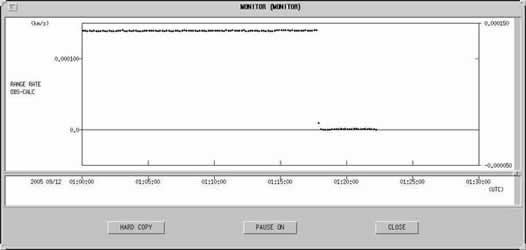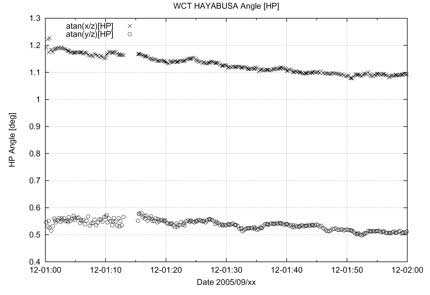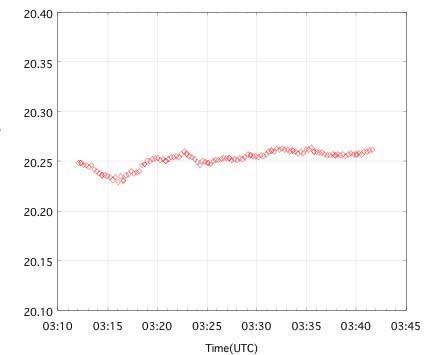TOP > Topics > 2005 > The doppler and altimeter data at Hayabusa arrival
![]()
The doppler and altimeter data at Hayabusa arrival
Figure-1 below shows the Doppler velocity difference between Itokawa and Hayabusa. The velocity dropped down to zero around 01:17 UTC. It indicates that Hayabusa fired its chemical propulsion thruster so that the relative velocity was canceled. Vertically approaching speed is taken in km/sec and is shown the doubled speed corresponding to a round trip measurement. Horizontally is shown the Universal Time (World Time: UTC) when the Doppler information was collected. Since radio travels for about 17 minutes from Hayabusa, the last firing occurred around 01:17 UTC. The resulted relative velocity was confirmed down to about 0.25 mm/sec.
Fig. 1 Doppler measurement at Stop Maneuver. (Displayed two times) |
Figure-2 draws the angular separation history of Hayabusa seen from Itokawa with respect to Earth direction. If Itokawa is purely spherical and Hayabusa is completely still to Itokawa, this separation angle stays zero. The motion perpendicular to Itokawa-Earth direction is hardly known from Doppler information. However, taking the advantage of this Navigation Camera plot as well as the Laser altimeter measurement, Hayabusa obtains the full motion information by itself aboard. This illumination tracking is affected by the shape and the rotation motion. After the stop maneuver, the Figure suggests that Hayabusa still moves about 0.1degree/hour, which corresponds to the lateral speed of 1cm/sec normal to Earth direction, with the illumination center drift incorporated.
Fig. 2 Optical Navigation : Illumination Center motion observed aboard. |
Figure-3 draws the Laser Altimeter measurement about two hours after the stop maneuver. Since Hayabusa is almost still to Itokawa, the range fluctuation comes from the terrain of Itokawa. The stop distance intended was about 20km relying on the Itokawa's ephemeris estimated based on the ground observation. However, the ephemeris contains some uncertainty and it affects the range measurement off-set. Details need to be analyzed.
Fig. 3 Laser Altimeter data after arrival |
Whether Hayabusa is still may be interpreted by looking at the relative speed that shall be within escape velocity. Current estimation says the escape velocity from Itokawa is about several centi-meters per second at the distance of 20km. In view of the above mentioned residual relative speed to Itokawa, it is satisfactorily interpreted that Hayabusa stays within the sphere of influence of Itokawa. Note the mass of Itokawa is one of the most important science observations in this Hayabusa mission.
With the residual speed of 1cm/sec, Hayabusa motion accompanies the angular separation shift of 3 degrees per day. Since the narrow angle camera field of view is +/- 3 degrees, this implies Hayabusa needs to correct its orbit. Hayabusa spacecraft is designed to perform this control automatically and the function will go into use soon.
September 13, 2005








